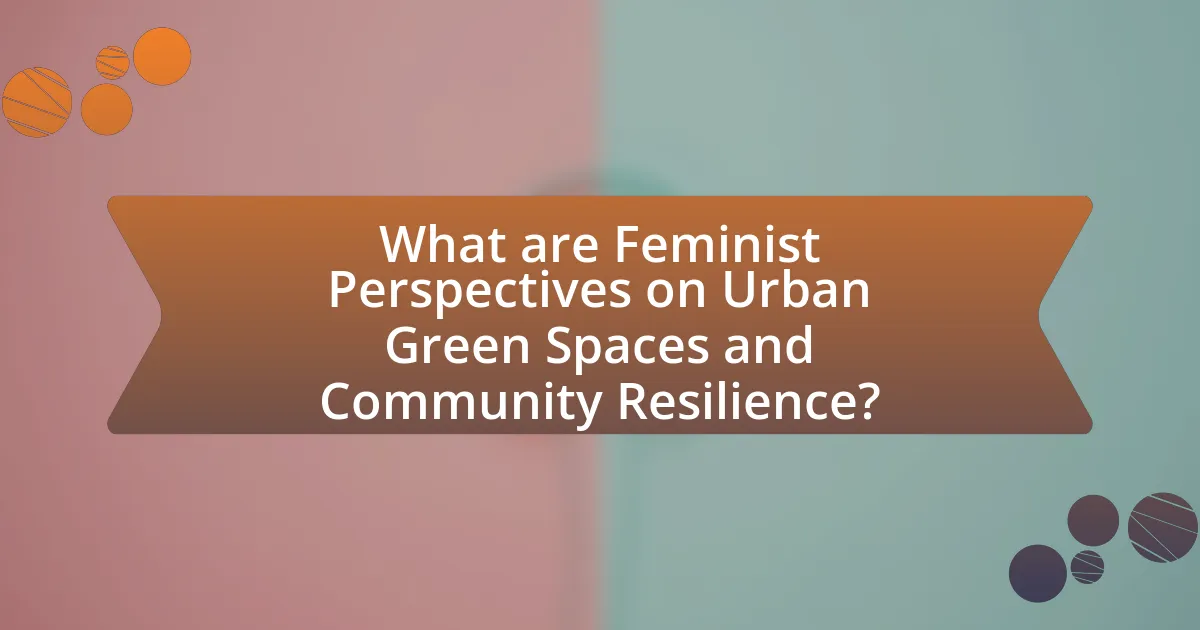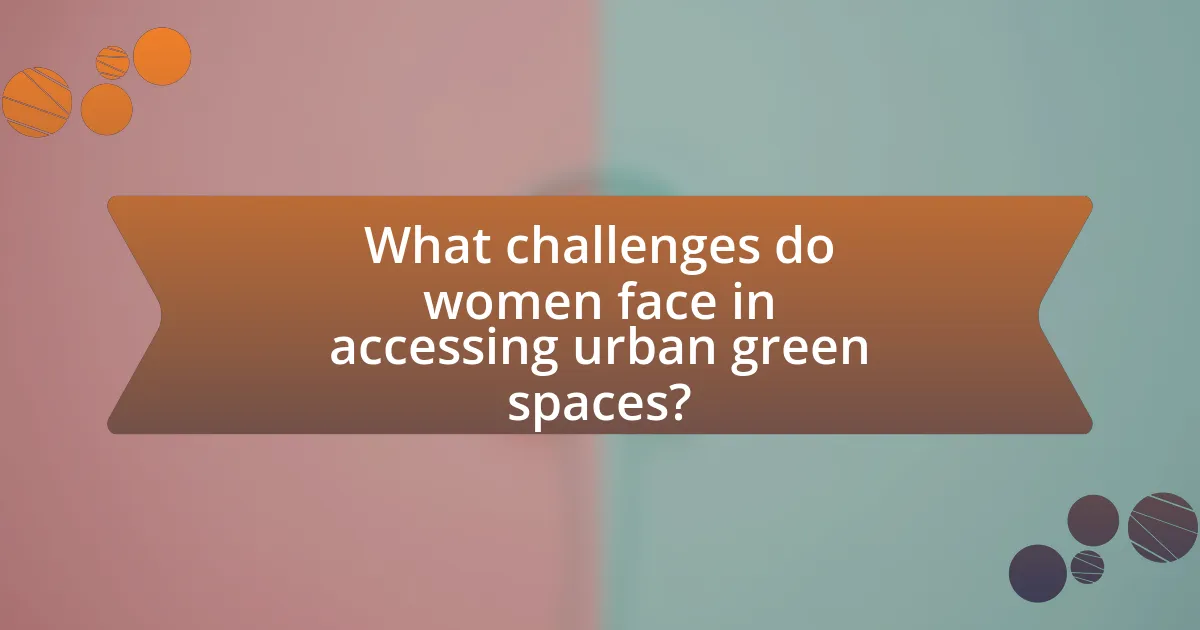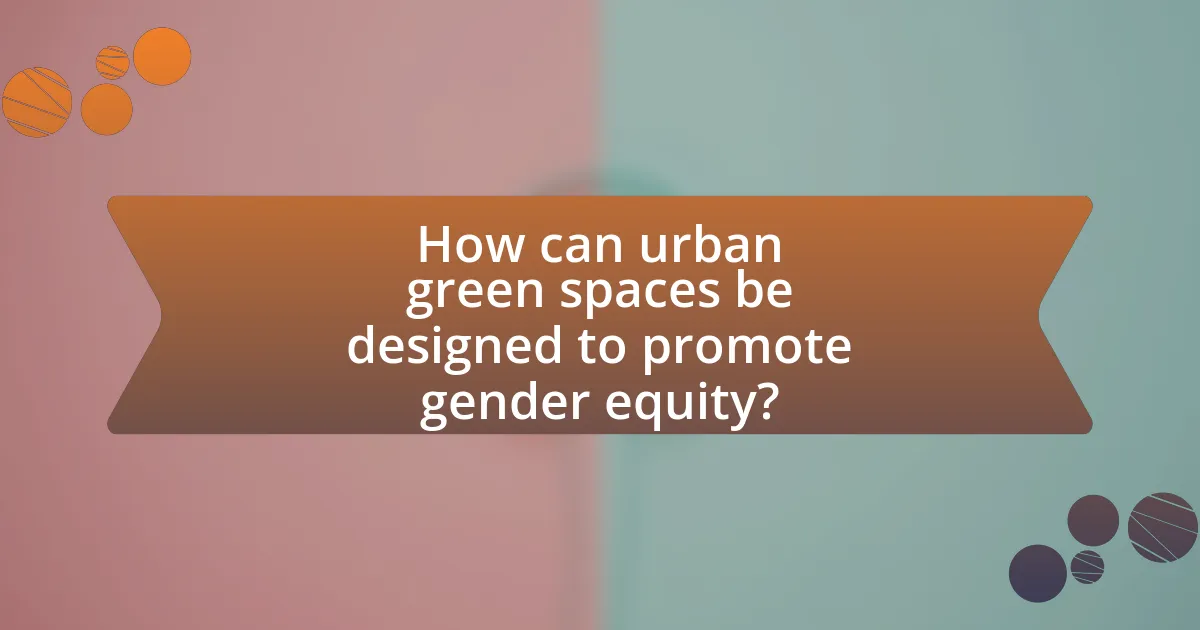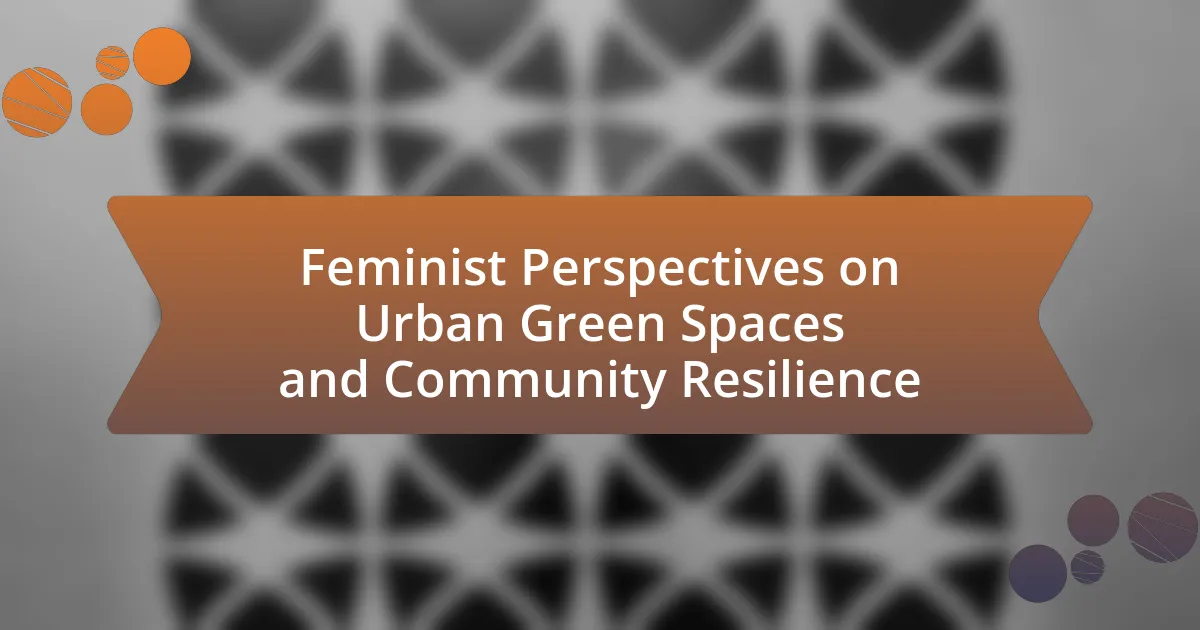The article examines feminist perspectives on urban green spaces and their role in enhancing community resilience. It highlights the importance of inclusivity and equity in the design and management of these spaces, particularly for marginalized groups such as women and low-income communities. Key concepts discussed include intersectionality, gendered spaces, and participatory planning, which inform how urban green spaces can be made more accessible and safe. The article also addresses the challenges women face in accessing these areas, the impact of social and economic factors, and strategies for improving access and participation in urban planning. Successful feminist-led initiatives are presented as examples of how inclusive design can foster community resilience and well-being.

What are Feminist Perspectives on Urban Green Spaces and Community Resilience?
Feminist perspectives on urban green spaces emphasize the importance of inclusivity, equity, and the role of these spaces in enhancing community resilience. These perspectives argue that urban green spaces should be designed and managed to address the needs of diverse populations, particularly marginalized groups, including women, children, and low-income communities. Research indicates that equitable access to green spaces contributes to social cohesion, mental well-being, and environmental justice, which are crucial for community resilience. For instance, a study by the University of California found that neighborhoods with accessible green spaces experience lower rates of social isolation and higher community engagement, demonstrating the positive impact of inclusive urban planning on resilience.
How do feminist theories inform our understanding of urban green spaces?
Feminist theories inform our understanding of urban green spaces by highlighting the intersectionality of gender, social equity, and environmental justice. These theories emphasize that urban green spaces are not neutral; they reflect and reinforce existing power dynamics, often marginalizing women and other underrepresented groups in their design and accessibility. For instance, research by the University of California, Berkeley, indicates that women often face barriers to accessing green spaces due to safety concerns and lack of amenities that cater to their needs, such as childcare facilities. This understanding encourages urban planners to create inclusive green spaces that consider diverse user experiences, ultimately fostering community resilience and promoting social equity.
What key feminist concepts are relevant to urban planning?
Key feminist concepts relevant to urban planning include intersectionality, gendered spaces, and participatory planning. Intersectionality emphasizes the interconnected nature of social categorizations such as race, class, and gender, which can influence individuals’ experiences in urban environments. Gendered spaces highlight how urban design can reflect and reinforce gender inequalities, affecting women’s safety, mobility, and access to resources. Participatory planning advocates for the inclusion of diverse voices, particularly marginalized groups, in the urban planning process, ensuring that the needs and perspectives of all community members are considered. These concepts are supported by research indicating that inclusive urban planning can lead to more equitable and resilient communities, as seen in studies like “Gender and Urban Space: A Global Perspective” by the United Nations, which illustrates the importance of integrating gender considerations in urban policy.
How do gendered experiences shape the use of urban green spaces?
Gendered experiences significantly influence how individuals utilize urban green spaces, with women often facing different challenges and opportunities compared to men. Research indicates that women are more likely to prioritize safety, accessibility, and social interaction in these environments, leading them to use green spaces differently. For instance, a study by the University of California found that women are more inclined to visit parks during daylight hours and prefer spaces that are well-maintained and populated, reflecting concerns about personal safety. Additionally, women often engage in community-building activities within these spaces, which fosters social resilience and enhances the overall use of urban green areas. This gendered perspective highlights the necessity for urban planners to consider diverse experiences to create inclusive and functional green spaces.
Why is community resilience important in the context of urban green spaces?
Community resilience is crucial in the context of urban green spaces because it enhances social cohesion, environmental sustainability, and adaptive capacity in urban areas. Urban green spaces serve as vital community hubs that foster interactions among residents, thereby strengthening social networks and support systems. Research indicates that neighborhoods with accessible green spaces report higher levels of community engagement and lower crime rates, which are essential components of resilience. Furthermore, these spaces contribute to environmental benefits such as improved air quality and biodiversity, which are critical for adapting to climate change impacts. Studies show that communities with robust green infrastructure are better equipped to recover from environmental shocks, demonstrating the interconnectedness of community resilience and urban green spaces.
What role do urban green spaces play in enhancing community resilience?
Urban green spaces significantly enhance community resilience by providing essential ecosystem services, promoting social cohesion, and improving mental health. These areas contribute to climate adaptation by reducing urban heat, managing stormwater, and improving air quality, which are crucial for communities facing environmental challenges. Research indicates that neighborhoods with accessible green spaces experience lower rates of heat-related illnesses and better flood management, thereby increasing their capacity to withstand climate impacts. Furthermore, urban green spaces serve as gathering places that foster community interaction and support networks, which are vital during crises. Studies show that communities with strong social ties are more likely to recover quickly from disasters, highlighting the importance of these spaces in building resilience.
How can feminist perspectives contribute to building resilient communities?
Feminist perspectives contribute to building resilient communities by emphasizing inclusivity, equity, and the importance of diverse voices in decision-making processes. These perspectives advocate for the integration of women’s experiences and needs in urban planning, which leads to more comprehensive and effective community solutions. Research shows that when women are involved in community development, there is a higher likelihood of addressing social inequalities and enhancing community cohesion. For instance, studies indicate that cities with gender-sensitive policies experience improved public safety and increased participation in community activities, ultimately fostering resilience in the face of challenges.

What challenges do women face in accessing urban green spaces?
Women face several challenges in accessing urban green spaces, including safety concerns, inadequate infrastructure, and socio-economic barriers. Safety concerns often stem from fears of harassment or violence in public spaces, which can deter women from utilizing these areas. Inadequate infrastructure, such as poorly maintained paths or lack of lighting, further complicates access, making it difficult for women, especially those with children or disabilities, to navigate these environments. Socio-economic barriers, including limited financial resources and time constraints due to caregiving responsibilities, also restrict women’s ability to visit and enjoy urban green spaces. Studies indicate that these factors collectively contribute to the underutilization of green spaces by women, highlighting the need for inclusive urban planning that addresses these specific challenges.
How do social and economic factors impact women’s access to these spaces?
Social and economic factors significantly limit women’s access to urban green spaces. Women often face barriers such as lower income levels, which restrict their ability to travel to or utilize these areas effectively. For instance, studies indicate that women are more likely to be responsible for childcare and household duties, which can confine their mobility and time spent in public spaces. Additionally, social norms and safety concerns can deter women from visiting these areas, particularly in neighborhoods with high crime rates. Research from the World Health Organization shows that women’s participation in outdoor activities is often influenced by perceived safety and accessibility, highlighting the need for inclusive urban planning that addresses these disparities.
What barriers exist for marginalized women in urban environments?
Marginalized women in urban environments face barriers such as limited access to safe public spaces, economic inequality, and inadequate healthcare services. These barriers restrict their ability to engage in community activities and access resources essential for their well-being. For instance, a study by the World Health Organization highlights that women in low-income urban areas often experience higher rates of violence and harassment in public spaces, which deters them from utilizing these areas. Additionally, economic disparities prevent marginalized women from accessing quality education and job opportunities, further entrenching their marginalization.
How do safety concerns affect women’s use of urban green spaces?
Safety concerns significantly limit women’s use of urban green spaces. Women often perceive these areas as unsafe due to factors such as inadequate lighting, lack of surveillance, and the potential for harassment, which leads to decreased visitation and engagement. Research indicates that women are more likely to avoid parks and green spaces that they perceive as unsafe, impacting their physical activity levels and social interactions. A study by the University of California, Berkeley, found that 60% of women reported feeling unsafe in public parks, which directly correlates with their reduced frequency of use. This avoidance not only affects women’s health and well-being but also diminishes their sense of community and belonging in urban environments.
What strategies can be implemented to improve access for women?
To improve access for women in urban green spaces, strategies such as designing inclusive public spaces, ensuring safety through adequate lighting and visibility, and providing transportation options specifically catering to women can be implemented. Research indicates that urban environments designed with women’s needs in mind, such as those highlighted in the “Gender and Urban Space” report by the United Nations, show increased usage and satisfaction among women. Additionally, community engagement initiatives that involve women in the planning and decision-making processes can lead to more equitable access and utilization of these spaces.
How can community engagement enhance women’s participation in urban green space planning?
Community engagement can enhance women’s participation in urban green space planning by creating inclusive platforms for dialogue and decision-making. Engaging women in community discussions allows their unique perspectives and needs to be recognized, leading to more equitable and accessible green spaces. Research indicates that when women are actively involved in planning processes, the resulting urban environments better reflect their preferences, which can improve community well-being and resilience. For instance, a study by the University of California found that women’s involvement in urban planning leads to the incorporation of features such as safe walking paths and community gardens, which are often prioritized by women. This demonstrates that community engagement not only empowers women but also results in urban spaces that cater to diverse community needs.
What role do local governments play in addressing these challenges?
Local governments play a crucial role in addressing challenges related to urban green spaces and community resilience by implementing policies that promote equitable access and sustainable development. They are responsible for planning, funding, and maintaining public green spaces, ensuring that these areas are accessible to all community members, particularly marginalized groups. For instance, local governments can create inclusive parks and community gardens that reflect the needs of diverse populations, thereby enhancing social cohesion and resilience. Research indicates that cities with well-maintained green spaces experience lower levels of social inequality and improved mental health outcomes, demonstrating the effectiveness of local government initiatives in fostering community well-being.

How can urban green spaces be designed to promote gender equity?
Urban green spaces can be designed to promote gender equity by ensuring accessibility, safety, and inclusivity for all genders. Designing pathways that are well-lit and visible can enhance safety, encouraging women and marginalized groups to use these spaces without fear. Additionally, incorporating diverse seating arrangements and recreational facilities can cater to various needs and preferences, fostering a sense of belonging. Research indicates that cities with inclusive green spaces see increased participation from women in community activities, which strengthens social ties and resilience. For example, a study by the University of California found that women are more likely to engage in community events in parks that are perceived as safe and welcoming.
What design principles support inclusive urban green spaces?
Design principles that support inclusive urban green spaces include accessibility, diversity, and community engagement. Accessibility ensures that green spaces are reachable for all individuals, including those with disabilities, by incorporating features like ramps and wide pathways. Diversity involves creating spaces that cater to various cultural and social groups, promoting a range of activities and plant species that reflect the community’s identity. Community engagement emphasizes involving local residents in the design and maintenance processes, fostering a sense of ownership and belonging. Research indicates that inclusive design leads to higher usage rates and satisfaction among diverse populations, as seen in studies conducted by the American Society of Landscape Architects, which highlight the importance of these principles in enhancing community resilience and social cohesion.
How can participatory design processes empower women in urban planning?
Participatory design processes empower women in urban planning by actively involving them in decision-making, ensuring their voices and needs are represented. This inclusion leads to the development of urban spaces that reflect women’s perspectives, enhancing community resilience and social equity. Research indicates that when women participate in urban planning, projects are more likely to address issues such as safety, accessibility, and environmental sustainability, which are often overlooked in traditional planning processes. For instance, a study by the United Nations Human Settlements Programme highlights that women’s involvement in urban design results in more inclusive public spaces, ultimately benefiting the entire community.
What features of urban green spaces are most beneficial for women and families?
The features of urban green spaces that are most beneficial for women and families include safety, accessibility, and opportunities for social interaction. Safe environments, such as well-lit paths and visible areas, reduce the risk of harassment and increase the likelihood of women and families using these spaces. Accessibility features, including ramps and seating, ensure that individuals of all ages and abilities can enjoy the green spaces. Additionally, areas designed for social interaction, such as playgrounds and community gardens, foster community ties and support family bonding. Research indicates that urban green spaces with these features contribute to improved mental health and well-being, particularly for women and children, by providing a refuge from urban stressors and promoting physical activity.
What examples exist of successful feminist-led urban green space initiatives?
Successful feminist-led urban green space initiatives include the “Women’s Park” in Chicago and the “Green Women” project in Berlin. The Women’s Park, established in 1994, was designed to honor women’s contributions to the city and features gardens, walking paths, and spaces for community gatherings, promoting social cohesion and environmental awareness. The Green Women project in Berlin focuses on creating green spaces that prioritize the needs and perspectives of women, integrating community input to enhance safety and accessibility. Both initiatives demonstrate how feminist leadership can effectively shape urban environments to foster community resilience and inclusivity.
How have these initiatives impacted community resilience?
Initiatives focused on feminist perspectives in urban green spaces have significantly enhanced community resilience by fostering inclusive participation and addressing diverse needs. These initiatives create safe, accessible environments that empower marginalized groups, leading to stronger social networks and increased community engagement. For instance, research indicates that urban green spaces designed with input from women and other underrepresented communities result in higher usage rates and improved mental well-being, which are critical components of resilience. Furthermore, studies show that communities with active participation in green space planning are better equipped to respond to environmental challenges, demonstrating a direct correlation between these initiatives and enhanced resilience.
What lessons can be learned from these case studies for future projects?
Case studies on feminist perspectives in urban green spaces reveal that inclusive design and community engagement are crucial for future projects. These studies demonstrate that involving diverse community voices leads to more equitable access and utilization of green spaces, fostering resilience. For instance, research indicates that projects incorporating feedback from marginalized groups result in higher satisfaction and usage rates, as seen in the successful implementation of community gardens in urban areas. This evidence underscores the importance of prioritizing inclusivity and collaboration in planning processes to enhance community resilience and ensure that urban green spaces serve all demographics effectively.
What best practices can be adopted to enhance feminist perspectives in urban green space planning?
To enhance feminist perspectives in urban green space planning, inclusive community engagement practices should be adopted. This involves actively involving women and marginalized groups in the planning process to ensure their needs and preferences are represented. Research indicates that when women participate in urban planning, the resulting spaces are more likely to address safety, accessibility, and social interaction, which are critical for community resilience. For instance, a study by the University of California found that women’s input in public space design leads to environments that better support family activities and social cohesion. Additionally, integrating gender-sensitive design principles, such as providing safe pathways, adequate lighting, and spaces for childcare, can significantly improve the usability of green spaces for all genders.
